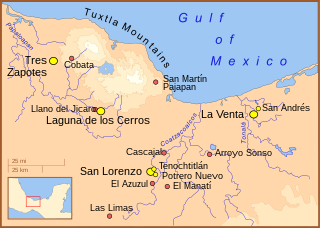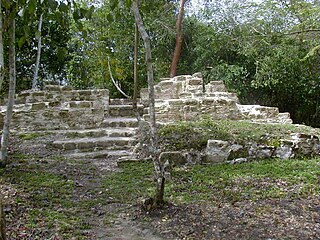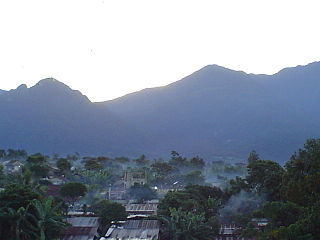Related Research Articles

The Olmecs were the earliest known major Mesoamerican civilization. Following a progressive development in Soconusco, they occupied the tropical lowlands of the modern-day Mexican states of Veracruz and Tabasco. It has been speculated that the Olmecs derived in part from the neighboring Mokaya or Mixe–Zoque cultures.

The International Council on Monuments and Sites is a professional association that works for the conservation and protection of cultural heritage places around the world. Now headquartered in Charenton-le-Pont, France, ICOMOS was founded in 1965 in Warsaw as a result of the Venice Charter of 1964 and offers advice to UNESCO on World Heritage Sites.

Xunantunich is an Ancient Maya archaeological site in western Belize, about 70 miles (110 km) west of Belize City, in the Cayo District. Xunantunich is located atop a ridge above the Mopan River, well within sight of the Guatemala border – which is 0.6 miles (1 km) to the west. It served as a Maya civic ceremonial centre to the Belize Valley region in the Late and Terminal Classic periods. At that time, when the region was at its peak, nearly 200,000 people lived in the Belize Valley.

Alberto Ruz Lhuillier was a Mexican archaeologist. He specialized in pre-Columbian Mesoamerican archaeology and is well known for leading the National Institute of Anthropology and History (INAH) excavations at the Maya site of Palenque, where he found the tomb of the Maya ruler, Pakal. Ruz Lhuillier is sometimes referred to as the "Hitchcock of Archaeology".
The Valletta Treaty (formally the European Convention on the Protection of the Archaeological Heritage (Revised), also known as the Malta Convention) is a multilateral treaty of the Council of Europe. The 1992 treaty aims to protect the European archaeological heritage "as a source of European collective memory and as an instrument for historical and scientific study". All remains and objects and any other traces of humankind from past times are considered to be elements of the archaeological heritage. The archaeological heritage shall include structures, constructions, groups of buildings, developed sites, moveable objects, monuments of other kinds as well as their context, whether situated on land or under water." (Art. 1)
The Venice Charter for the Conservation and Restoration of Monuments and Sites is a set of guidelines, drawn up in 1964 by a group of conservation professionals in Venice, that provides an international framework for the conservation and restoration of historic buildings. However, the document is now seen as outdated, representing Modernist views opposed to reconstruction. Reconstruction is now cautiously accepted by UNESCO in exceptional circumstances if it seeks to reflect a pattern of use or cultural practice that sustains cultural value, and is based on complete documentation without reliance on conjecture. The change in attitude can be marked by the reconstruction in 2015 of the Sufi mausoleums at the Timbuktu World Heritage Site in Mali after their destruction in 2012.

The Maya Biosphere Reserve is a nature reserve in Guatemala managed by Guatemala's National Council of Protected Areas (CONAP). The Maya Biosphere Reserve covers an area of 21,602 km², one-fifth of the country's total land area.

El Pilar is an ancient Maya city center located on the Belize-Guatemala border. The site is located 12 kilometres (7.5 mi) north of San Ignacio, Belize and can be accessed through the San Ignacio and Bullet Tree Falls on the Belize River. The name "El Pilar" is Spanish for "watering basin", reflecting the abundance of streams around the site and below its escarpment, which is rare in the Maya area.

Chocolá is a Preclassic Southern Maya site whose developmental emphasis was from c. 1000 BC to AD 200. The site lies within the Southern Maya area.

Oxtotitlán is a natural rock shelter and archaeological site in Chilapa de Álvarez, Mexican state of Guerrero that contains murals linked to the Olmec motifs and iconography. Along with the nearby Juxtlahuaca cave, the Oxtotitlán rock paintings represent the "earliest sophisticated painted art known in Mesoamerica", thus far. Unlike Juxtlahuaca, however, the Oxtotitlán paintings are not deep in a cave system but rather occupy two shallow grottos on a cliff face.
Joyce Marcus is a Latin American archaeologist and professor in the Department of Anthropology, College of Literature, Science, and the Arts at the University of Michigan, Ann Arbor. She also holds the position of Curator of Latin American Archaeology, University of Michigan Museum of Anthropological Archaeology. Marcus has published extensively in the field of Latin American archaeological research. Her focus has been primarily on the Zapotec, Maya, and coastal Andean civilizations of Central and South America. Much of her fieldwork has been concentrated in the Valley of Oaxaca, Mexico. She is known for her "Dynamic model", four-tiered hierarchy, and her use of interdisciplinary study.

Uxbenka is a pre-Columbian Mesoamerican archaeological site located in Belize's southernmost district of Toledo. An urban settlement of the pre-Columbian Maya, it is the earliest-known Maya polity in the southern Belizean lowlands, with evidence of occupation dating to the Early Classic period of Mesoamerican chronology. It is one of five major Maya sites in this region, whose archaeological sites also include Nim Li Punit and Lubaantun. Settlement of Uxbenka has been suggested to have occurred originally by Peten peoples. The site is approximately 40 square kilometers in size, and Uxbenka is referred to as a medium-sized polity ). Uxbenka rose shortly after the expansion of another Mayan site: Tikal. The site is thought to have been first inhabited during the late Preclassic period.

Chichén Itzá was a large pre-Columbian city built by the Maya people of the Terminal Classic period. The archeological site is located in Tinúm Municipality, Yucatán State, Mexico.
Diane Zaino Chase is an American anthropologist and archaeologist who specializes in the study of the Ancient Maya.

Arlen F. Chase is a Mesoamerican archaeologist and a faculty member in the anthropology department at Pomona College, Claremont CA. Previously, he was a professor at the University of Nevada, Las Vegas and served a variety of administrative roles at the University of Central Florida over the course of his 32 year stay at that institution. He is noted for his long-term research at the ancient Maya city of Caracol, Belize and for exploring landscape traces of Maya civilization using lidar.
Pusilhá is an archaeological site in Belize. The location of this Late Classic Maya urban complex, along the east and west flow of trade, made the city a major transfer point for economic activities in the whole region. In addition, the city gave archaeologists a historical view of a secondary Maya site. Large and extended excavation efforts have changed the overall picture of Maya social and political relationships between larger and smaller cities and challenged the prevailing view of conquest and absorption of smaller cities into the larger cities in the region. The research conducted at Pusilhá began in 1927 and continues to this day.

Anabel Ford is an American archaeologist specializing in the study of Mesoamerica, with a focus on the lowland Maya of Belize and Guatemala. She is recognized for her discovery of the ancient Maya city El Pilar. Ford is currently affiliated with the Institute of Social Behavioral and Economic Research (ISBER) and is the director of the MesoAmerican Research Center (MARC) at the University of California, Santa Barbara.
Ronald Nigh is an American ecological anthropologist focusing on Caribbean areas and the Maya region in Mesoamerica. Nigh is a professor and researcher at Centro de Investigaciones y Estudios Superiores en Anthropologia Social (CIESAS), where he continues his research on ecological anthropology.
Exploring Solutions Past: the Maya Forest Alliance is a nonprofit organization focused on preserving the Maya forest as a cultural resource for global significance. Exploring Solutions Past suggests that environmentally based indigenous practices might improve contemporary problems such as conservation and resource abundance. This organization combines the efforts of different fields and groups of people in order to promote a more sustainable future.
References
- ↑ "Archaeology Under the Canopy". Exploring Solutions Past. Retrieved 26 September 2015.
- ↑ "Archaeology Under the Canopy". MesoAmerican Research Center.
- ↑ Ford, Anabel; Havrda, Matyas. Tourism, Consumption and Representation: Narratives of Place and Self. Wallingford: CAB International. pp. 67–93. ISBN 9780851996783.
- ↑ "Adaptive Management in the Maya Forest: The Contiguous Parks at El Pilar" (PDF). Mesoamerican Research Center.
- ↑ Preucel, Robert; Mrozowski, Stephen (2010). Contemporary Archaeology in Theory: the new pragmatism. John Wiley & Sons. ISBN 978-1405158534.
- ↑ Ford, Anabel; Havrda, Matyas. Tourism, Consumption and Representation: Narratives of Place and Self. Wallingford: CAB International. pp. 67–93. ISBN 9780851996783.
- ↑ "Experience El Pilar". Mesoamerican Research Center. Retrieved 26 September 2015.
- ↑ Carr, Archie. "Ecology of the Maya Forest and El Pilar" (PDF). Mesoamerican Research Center. Retrieved 26 September 2015.
- ↑ Ford, Anabel; Montes, J.A. (1999). "Environment, Land Use, and Sustainability: Implementation of the El Pilar Archaeological Reserve for Maya Flora and Fauna, Belize-Guatemala". Mesoamerica. 37: 31–50.
- ↑ "The Athens Charter for the Restoration of Historic Monuments - 1931". ICOMOS. Retrieved 26 September 2015.
- ↑ "The Venice Charter". ICOMOS. Retrieved 26 September 2015.
- ↑ "Charters". Australian ICOMOS. Retrieved 26 September 2015.